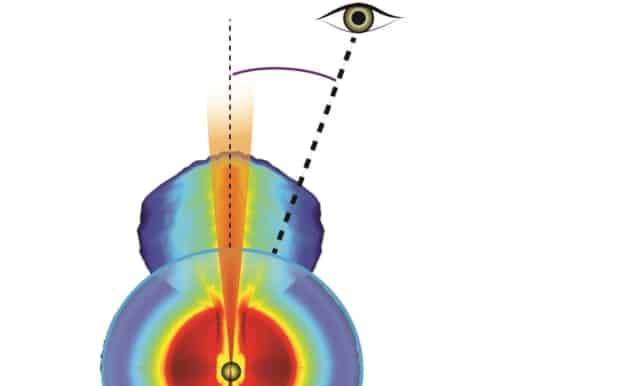
The puzzling inconsistency between different measurements of the Hubble constant, which describes rate of expansion of the universe, could soon be better understood thanks to a new technique for analysing the explosive merger of two neutron stars.
Conflicting measurements of the Hubble constant arise from two different methods that have been used to measure the parameter. One involves observing stellar explosions called type Ia supernovae and the other involves fitting cosmological models to the cosmic microwave background (CMB) radiation.
The supernova method gives a Hubble constant of 73.5 km/s/Mpc, where a parsec (pc) is 3.26 light-years. This means that a point one million parsecs from Earth is expanding away from Earth at a rate of 73.5 km/s. Meanwhile, analysis of the European Space Agency’s Planck spacecraft’s observations of the CMB suggest a Hubble constant of 67.4 km/s/Mpc. While there are uncertainties in both measurements, the disagreement between the two values is statistically significant.
New physics?
The conflict suggests that either there is a flaw (or flaws) in how one or both measurements are made and interpreted; or that some sort of new physics is at work. Either way, solving the mystery will reveal new and potentially useful information and physicists are therefore keen on developing new and independent ways of calculating the Hubble constant.
One promising method it to study the gravitational waves and light that are produced in the merger of two neutron stars. This involves measuring the strength of the gravitational wave signal – which gives the distance to the merger – and the redshift of the light, which gives the speed at which the merged object is moving away from Earth. Such measurements are now possible thanks to the LIGO and Virgo gravitational-wave detectors, which have already seen one merger (called GW170817) and should see more.
The main challenge in using this technique is that the observed strength of the gravitational waves depends strongly on Earth’s relative orientation to the orbital plane of the neutron stars before they merged. If we happen to be looking along the direction perpendicular to the orbital plane, we will see the strongest signal. If not, the signal strength will be weaker. Therefore, the angle of inclination between the perpendicular and our direction of view is needed to calculate the distance to the merger.
Many mergers needed
One way of determining this angle is to measure the polarization of the gravitational waves. Earlier this year Stephen Feeney of the Flatiron Institute in New York City, Hiranya Peiris of University College London and colleagues showed that an accurate determination of the Hubble constant could be made in this way by studying approximately 50 neutron-star merger events.
Now, astronomers led by Kenta Hotokezaka of Princeton University have developed a new way of measuring the angle and have used it to analyse data from GW170817. It involves studying the relativistic jet of particles that blasts out of the black hole that was created by the merger. This jet should be perpendicular to the orbital plane and can be studied by observing the strong radio signal it emits.
Hotokezaka and colleagues developed a technique for measuring the opening angle of the jet, which defines how the jet spreads out as it moves away from the black hole (see figure). Once they had the opening angle, they can work-out the inclination angle required to calculate the Hubble constant.
Using data from GW170817 they obtain a Hubble constant of 70.3 km/s/Mpc. The uncertainty in the result is fairly large so their result overlaps both the CMB and supernovae values – so clearly just one merger observation is not enough to solve the mystery. However, Hotokezaka’s group estimate that a sample of just 15 gravitational wave events for which the opening angle can be measured should be enough to provide a meaningful value of the constant.
Middle ground
A likely outcome is that the neutron-star measurements will agree with either the CMB or supernovae value. However, Hotokezaka tells Physics World, “we think it is still possible that the true value [of the Hubble constant] is somewhere between the two”. If the value of the Hubble constant as measured by gravitational waves were to stay around 70.3 km/s/Mpc, it would imply that either there are inaccuracies in both the supernovae and CMB methods, which seems unlikely, or that new physics is involved.

Gravitational waves could resolve Hubble constant debate
Nobel laureate Adam Riess of the Johns Hopkins University and the Space Telescope Science Institute leads a project called SH0ES that measures the Hubble constant using type Ia supernovae. He says that the new technique is “promising for getting a result from gravitational waves sooner, due to the lower error per object”.
Indeed, it could take only another 5-10 years to detect enough gravitational wave events with observable afterglows, particularly if the forthcoming Japanese Kamioka Gravitational Wave Detector and LIGO India can team up LIGO and Virgo.
Hotokezaka and colleagues describe their work in Nature Astronomy.



